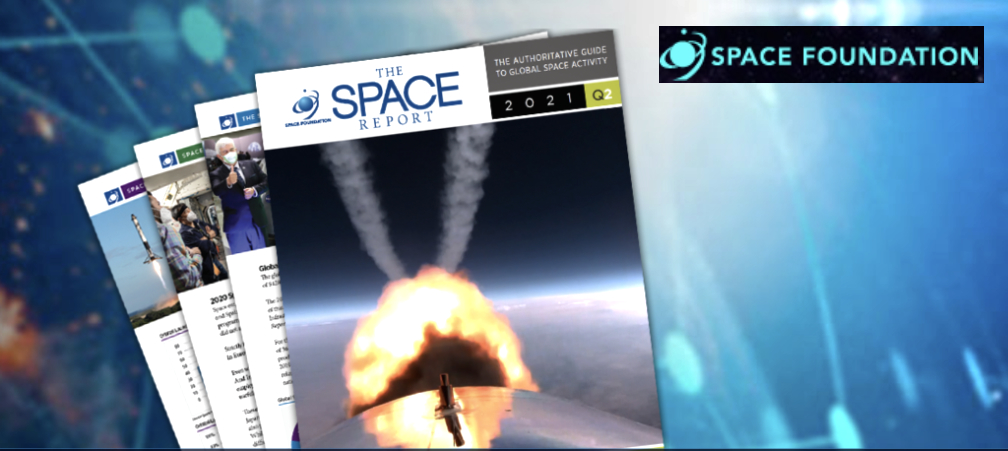
Commercial space grew 6.6% in 2020, representing nearly 80% of space economy — the US, China and ESA remain the top three investors in global space economy— US military space spending increased 6.1% in 2020, reaching new height of $26.6 billion.
Space Foundation, a nonprofit advocate organization founded in 1983 for the global space ecosystem, has just released “The Space Report 2021 Q2,” which examines global space economy growth and trends in 2020, the continuing growth of commercial space activity, notable shifts in the global space economy, and U.S. military space spending in 2020.
“The Space Report 2021 Q2” found that in 2020 the global space economy rose to $447 billion, an increase of 4.4% from a revised 2019 total of $428 billion. This $447 billion space economy is 55% higher than a decade ago and part of a five-year trend of uninterrupted growth.
Commercial space activity grew 6.6% to nearly $357 billion in 2020, still representing close to 80% of the total space economy. Global government space spending fell 1.2% in 2020 to $90.2 billion from a revised 2019 peak of $91.4 billion. Nearly 58% of this total was allocated to space activities by the U.S.

Reflecting on the newly released data, Space Foundation CEO, Tom Zelibor, said, “The global space ecosystem is an emerging force for continued growth and expanded opportunity worldwide. The Space Report’s Q2 findings verify that the global space economy not only weathered but actually emerged stronger from the worldwide pandemic that spanned three quarters of the year. It also validates the strength and resilience of the space ecosystem and illustrates why it’s well positioned for growing investment, market development, and employment opportunities across multiple sectors.”
Globally, the top three investors in the global space economy remained the same in 2020: the United States, China and the European Space Agency. Collectively, these three entities constituted more than 81% of government space spending in 2020.
This year’s analysis also revealed notable shifts in the global space economy. Japan’s 3% space budget increase in 2020 played opposite Russia’s 37% reduction to make Japan the fourth-highest contributor to the global space economy.
France increased its domestic funding by more than 40% in 2020, leapfrogging Germany and India to become the seventh-largest contributor to the global space economy in 2020 after Russia and the European Union. Lastly, Italy’s 37% budget reduction shifted its 2019 ranking of 11 down to 12 in 2020, beneath Canada.
“The Space Report 2021 Q2” edition also investigates changing trends in global space spending between 2019 and 2020, revealing surprising spending decreases in traditionally dominant and developing space nations.
The Q2 edition also delves into military space spending in 2020, estimated at $31.4 billion, which constituted the smallest share of global government space spending in a decade — only 35%. Military space spending in the United States, however, increased by 6.1% in 2020, reaching a new height of $26.6 billion and comprising more than 80% of global military space spending for the first time since 2011.
Also included in this informative report are additional insights, such as the trends in global space workforce employment, an analysis of President Biden’s FY2022 space budget, a midyear update on 2021 launch activity plus Q2 investment and market analysis.
The Space Report is the authoritative report on the global space ecosystem, covering space exploration and space-inspired industries on Earth. Published by Space Foundation since 2006, The Space Report, part of Symposium 365, is available on a subscription basis, providing policy analysts, congressional staff, investors, media, and space industry newcomers with research and insight on trends and opportunities with informative articles and quarterly reports. Highlighting each report is an overview of the latest data available on the space economy, space infrastructure and other key industry indicators as well as analysis of commercial, government and educational events impacting business, workforce and our daily lives.
Symposium 365, a division of Space Foundation, is the premier source for media and events in the global space ecosystem, offering authoritative news and information and venues for networking and conducting business via the world-renowned Space Symposium, Symposium 365 Digital Platform and The Space Report. Serving commercial, government and education sectors, Symposium 365 produces signature programming — live and online — for professionals, entrepreneurs, educators and students to learn, connect and conduct business 365 days a year. To learn more about Symposium 365, please visit .
Space Foundation is a nonprofit advocate organization founded in 1983, offering a gateway to information, education and collaboration for space exploration and space-inspired industries that define the global space ecosystem. Driven by a partnership model, Space Foundation operates three divisions that unite the entire spectrum of stakeholders — business, government, education and local communities — through corporate membership, sponsorship, fundraising and grants: Symposium 365 is the premier source for media and events, including the world-renowned Space Symposium and The Space Report. Center for Innovation and Education is a lifelong learning platform. Global Alliance facilitates collaboration around the world.
